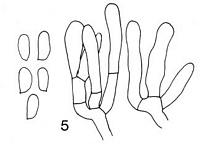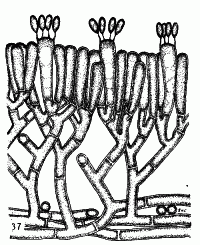|
 Phanerochaete corymbata Phanerochaete corymbata
SynonymsCorticium corymbatum
Ceraceomyces corymbatus
BiostatusPresent in region - Indigenous. Non endemic
Images (click to enlarge)
Caption: 5. C. corymbatum, spores and young basidia. | 
Caption: TEXT-FIG. 37. Corticium corymbatum. x 1000. | 
Caption: FIG. 17. Phanerochaete corymbatum (holotype), a. subicular hyphae, b. basidia, and c.
basidiospores. |
Article: Cunningham, G.H. (1954). Thelephoraceae of New Zealand. Part III: the genus Corticium. Transactions of the Royal Society of New Zealand 82(2): 271-327.
Description: Hymenophore annual, adnate, membranous, effused, forming linear areas to 40 x 3 cm. with
numerous outlying islands; surface cream, even, not creviced; margin thinning out, white,
arachnoid, adnate. Context white, 40-80 µ thick, composed of a narrow basal layer of parallel
hyphae, and an intermediate layer of erect hyphae sparsely branched below, freely branched
(corymbose) beneath the hymenium; generative hyphae 4.5-5 µ diameter, wall 0.5 µ thick,
naked or occasional hyphae coated with fine crystals, hyaline, septate, without clamp
connections. Hymenial layer to 40 µ deep, of basidia and paraphyses compacted into a dense
palisade. Basidia subclavate, slightly projecting, 16-20 x 4-5 µ, 4-spored; sterigmata slender,
to 4 µ long. Paraphyses subclavate, similar to the basidia but narrower. Spores obovate or
elliptical, with rounded apex and acuminate base, 6-7 x 3-3.5 µ, apiculate, wall smooth,
hyaline, 0.2 µ thick.
Distribution: DISTRIBUTION. New Zealand.
Notes: In the type collection the hymenophore is closely adnate, with an even, non-creviced cream
surface, thin context with hyphae scantily branched below, corymbose beneath the
hymenium, arising from a narrow basal layer of parallel hyphae, naked save for occasional
hyphae which are finely crystal coated. The collection from Pittosporum differs in that the
fructification is loosely attached, has a deeply creviced surface, hyphae are thinner, with
thinner walls, and the basal layer is stouter. Occasional hyphae bear crystals, but most are
naked. When further collections come to hand it may prove to be distinct.
Article: Stalpers, J.A. (1985). Type studies of the species of Corticium described by G.H. Cunningham. New Zealand Journal of Botany 23(2): 301-310 (http://www.rsnz.org/publish/abstracts.php).
Description: Basidiome thin membranaceous. Hymenial surface cream-coloured to pale yellowish.
Subicular hyphae hyaline, thin- to slightly thick-walled, 2.5-4.5 µm wide, without clamps,
often branching at right angles. Subhymenial hyphae thin-walled, 2.5-3.5 µm wide, often
sparsely covered with crystalline material. Basidia clavate to subcylindrical, 18-28 X 4-5 µm.
Spores hyaline, thin-walled, smooth, navicular to narrowly ellipsoid, rarely subcylindrical,
6.5-7.5(-8) X 2.5-3 x 3-3.5 µm.
Notes: The species takes an intermediate position between Ceraceomyces Jlich and
Ceraceomerulius (Parm.) J. Erikss. & Ryv. Despite the absence of clamps it is placed in the
former genus because of the structure of the basidiome. The type of rot is indistinct.
Article: Burdsall, H.H. (1985). A contribution to the taxonomy of the genus Phanerochaete (Corticiaceae, Aphyllophorales). Mycologia Memoirs 10: 165 p.
Description: Basidiocarp broadly effuse, up to 15 x 2.5 cm in extent, up to 150 µm thick,
membranous, tightly adherent; fertile area continuous, smooth, not cracked, "yellowish
white" (3A2) to "dull yellow" (3B4); margin up to 0.25 mm wide, thinning out, fibrillose,
irregular in outline, white. Hyphal system monomitic. Subiculum a textura intricata, hyphae
3.5-5.5 µm diam, thin walled or firm walled, hyaline, long celled, simple septate,
smooth; subhymenium a compact textura intricata porrecta, hyphae 2.5-3.5 µm diam, thin
walled, hyaline, short celled, simple septate; cystidia lacking; basidia clavate with slight
median constriction, (27-)35-40 x 6.5-8.5 µm, thin walled, hyaline, 4-sterigmate,
sterigmata up to 5 um long; basidiospores narrowly ellipsoid, (7-)8-9.5 x 3.5-4.5 µm,
hyaline, thin walled, smooth, Melzer's -, acyanophilous.
Habitat: On hardwood branches; associated with a white rot.
Distribution: Known only from New Zealand and Louisiana.
Notes: Discussion: Phanerochaete corymbata is similar to P. auratum, P. tuberculata, and P.
xerophila. It differs from P. auratum that has hyphae more than 6 µm wide and wider
spores 7.5-9 x 4.5-5.5(-6) µm. Phanerochaete tuberculata has a fibrillose to nearly
cordonic basidiocarp, some nodose septate hyphae, and basidiospores 6-7.5 x 3.5-4.5 µm.
Phanerochaete xerophila has basidiospores 6-8 x 3.5-4.5 µm giving them a more broadly
ellipsoid shape than in P. corymbata.
This species has been collected recently in Louisiana, the first time since its original
collection. This results in an unusual distribution for this poorly known species. The
second specimen differs from the type only in possessing a highly cracked fruiting body
and hyphae encrusted with hyaline crystals.
|